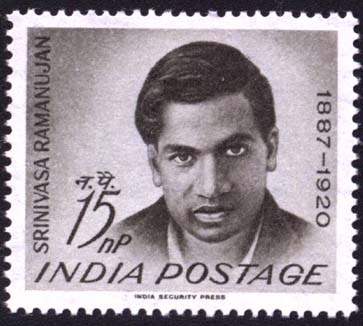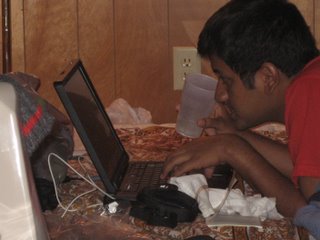Srinivasa Ramanujan Iyengar
This idea has been on the back of my mind for quite sometime, but like always, the quintessential lackadaisical attitude never let the mind make the first propulsion. I sat pondering one day about famous people whom I have read about in length. By the phrase 'in length', I mean that I have made a conscientious attempt to explore more about their life stories than just a pedantic attempt. In the following few monographs ('blogs' sounded too rustic and crude), I would attempt to make a short sketch of their lives. I would have wanted to avoid biographical details that may be found in books written by very competent authors more dedicated to the cause than a tinker like me. But facts and details somehow induce chronology and coherence to a literary attempt. They also enable the writer to communicate in a language that the reader can follow and not delve too much into his own mystical abstractions which may sound profound but are in reality, very perfunctory. But to state once again, this is not a biography and does not follow the person's entire life history. It may best be visualised as an abridgement of their life stories written not by a professional biographer but a mere college undergraduate who feels truly enthralled to know them and is excited to share the story.
 Srinivasa Ramanujan Iyengar was born to a modest brahmin family in 1887 in a small town called Erode. This was a period when India was under the British imperialistic regime. 1865 to 1910 could be considered as a fairly dormant period as far as the anti-British revolution was concerned. Moreover, South India was in the true sense of the word, never really rebellious in nature. Ramanujan was born at a time when western education was encouraged and accepted by the bourgeoise and thus, it was a time when local government colleges were producing a decent output of competent Indian graduates in the sciences, literature and engineering. But the British used to discriminate shamlessly when it came to positions in the government and corporate firms. The educated Indian bourgeoise could at best, hold positions of Diwans or clerks in the British machinery. So to speak, India had not really produced any real 'scientist' till then who was noticed by the rest of the world, but academic societies had sprouted and were active in the country. For instance, there was the Indian Mathematical Society which produced a periodic journal which had contributions from local Indian amateur mathematicians and mathematics professors. The society had members from the educated Indian middle class, for whom mathematics was a penchant and an escape from the mundane clerical work that was imposed upon them by the British employment structure, clearly belittling their education and intellect. But like it is always a choice between the lesser of two evils, the fact that the Indian bourgeoise had access to education ensured the advent of an intellectual renaissance in India in the latter half of the nineteenth century. If it were not for this, Ramanujan's birth and existence would have probably been reduced to an anachronism and he would have been lost in oblivion.
Srinivasa Ramanujan Iyengar was born to a modest brahmin family in 1887 in a small town called Erode. This was a period when India was under the British imperialistic regime. 1865 to 1910 could be considered as a fairly dormant period as far as the anti-British revolution was concerned. Moreover, South India was in the true sense of the word, never really rebellious in nature. Ramanujan was born at a time when western education was encouraged and accepted by the bourgeoise and thus, it was a time when local government colleges were producing a decent output of competent Indian graduates in the sciences, literature and engineering. But the British used to discriminate shamlessly when it came to positions in the government and corporate firms. The educated Indian bourgeoise could at best, hold positions of Diwans or clerks in the British machinery. So to speak, India had not really produced any real 'scientist' till then who was noticed by the rest of the world, but academic societies had sprouted and were active in the country. For instance, there was the Indian Mathematical Society which produced a periodic journal which had contributions from local Indian amateur mathematicians and mathematics professors. The society had members from the educated Indian middle class, for whom mathematics was a penchant and an escape from the mundane clerical work that was imposed upon them by the British employment structure, clearly belittling their education and intellect. But like it is always a choice between the lesser of two evils, the fact that the Indian bourgeoise had access to education ensured the advent of an intellectual renaissance in India in the latter half of the nineteenth century. If it were not for this, Ramanujan's birth and existence would have probably been reduced to an anachronism and he would have been lost in oblivion.With this background of an India saddled under imperialism, we now picture a small town in southern India, where, in the midst of the tropical heat, a young brahmin boy with an extraordinary acumen for mathematics was growing up. Ramanujan established his mathematical skills right from childhood among his peers and school teachers. Not only did he unflinchingly score a centum in every school exam he was also known to walk out of the examination hall in one third of the time while his oblivious classmates still sat wrestling difficult questions in elementary algebra and euclidean geometry. One of his contemporaries at school, who later outlived him that Ramanujan used to impress his fellow school mates by his ability to recite the value of pi upto a hundred decimal places from his memory. While he was in seventh grade he prepared a time-table for his entire school, a job that was entrusted to him by his mathematics teacher who found it difficult to construct one himself which would avoid time-slot clashes for a handful of teachers tutoring multiple classes. Round about the same time Ramanujan laid his hands on S. L. Loney's classic textbooks on elementary trigonometry and co-ordinate geometry. These were university level texts at that time, Loney being a mathematics professor in England. Ramanujan mastered these texts while he was barely thirteen ( I personally recollect myself struggling with some of the advanced problems in these books while I was 17 and preparing for my JEE). But the important thing was, that these experiences motivated Ramanujan to carve out a path of originality and extrapolate to really advanced original mathematics from simple elementary texts.
Ramanujan's father was an ordinary clerk, a devout and pious man. His mother, a devout Hindu woman, exerted more influence on Ramanujan's life than his father. Ramanujan was the eldest of three brothers. As records speak, no one in his family, both immediate and extended, is known to have possessed an interest for higher academics, let alone a genius of the magnitude even close to that of Ramanujan. But like most Brahmin families in the south, his was one who valued education, and it did not take them long to realise that Ramanujan was gifted. Ramanujan himself was a Hindu with religious values strongly ingrained into him. He commonly mentioned to his friends and contemporaries that the local diety, the goddess of Namagiri used to appear in his dreams and used to convey mathematical theorems to him. An Indian contemporary of Ramanujan in Cambridge later recalled that the genius once mentioned to him that "A mathematical theorem is useless to me unless it expresses a thought of God." It is queer sometimes to a person like me, one who calls himself an 'agnostic' (it sounds more intellectual than 'aethist') that such unparalleled genius can exist and propagate inside a a ghetto of innocence and blinded faith. Perhaps, it would be queer to the reader too that an unknown man in southern India, with no formal training with mathematics and no access to international mathematical work close to a hundred years of his time could, from elementary textbooks, extrapolate theories that had baffled famous mathematicians for over 300 years, and yet claim that an inanimate object of worship conveyed them to him in his dreams. Perhaps what we lack is faith which dissolves all intellectual masquerades that all of us put on.
Coming back to his life in High School, Loney's books made the young Ramanujan realise his penchant for mathematics and transform it into a passion. They introduced him into a confluence of trigonometry and algebra which he tackled with finesse. He also spent sometime on geometry, but later on realised that algebra was what he'd like to invest his time upon. Loney's books introduced him to infinite series, an area in which he would prove himself to be the supreme master pretty soon. Ramanujan's family frequently rented out rooms to university college students. This was another important phase in his life and it is believed that he taught himself calculus and higher algebra in their company and in no time he started attending their queries and doubts. When he was of age 16-17, an elder friend procured Ramanjuan, an old mathematical textbook, outdated by 50 years even in those times. This old, out of print book was the pandora's box that opened Ramanujan's genius to the entire world.
(to be continued...)











